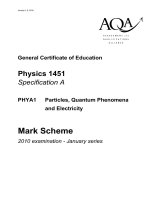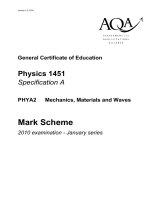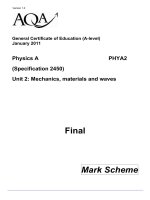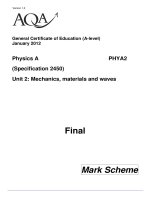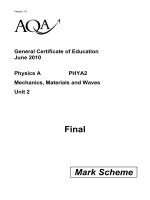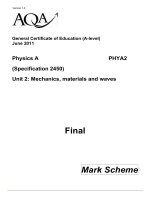AQA ANTH2 w MS JUN15
Bạn đang xem bản rút gọn của tài liệu. Xem và tải ngay bản đầy đủ của tài liệu tại đây (123.94 KB, 17 trang )
A-LEVEL
Anthropology
ANTH2/Unit 2 Becoming a Person: Processes, Practices and
Consequences
Mark scheme
2110
June 2015
Version 1.0: Final
Mark schemes are prepared by the Lead Assessment Writer and considered, together with the
relevant questions, by a panel of subject teachers. This mark scheme includes any amendments
made at the standardisation events which all associates participate in and is the scheme which was
used by them in this examination. The standardisation process ensures that the mark scheme covers
the students’ responses to questions and that every associate understands and applies it in the same
correct way. As preparation for standardisation each associate analyses a number of students’
scripts: alternative answers not already covered by the mark scheme are discussed and legislated for.
If, after the standardisation process, associates encounter unusual answers which have not been
raised they are required to refer these to the Lead Assessment Writer.
It must be stressed that a mark scheme is a working document, in many cases further developed and
expanded on the basis of students’ reactions to a particular paper. Assumptions about future mark
schemes on the basis of one year’s document should be avoided; whilst the guiding principles of
assessment remain constant, details will change, depending on the content of a particular
examination paper.
Further copies of this Mark Scheme are available from aqa.org.uk
Copyright © 2015 AQA and its licensors. All rights reserved.
AQA retains the copyright on all its publications. However, registered schools/colleges for AQA are permitted to copy material from this
booklet for their own internal use, with the following important exception: AQA cannot give permission to schools/colleges to photocopy any
material that is acknowledged to a third party even for internal use within the centre.
MARK SCHEME – A-LEVEL ANTHROPOLOGY – ANTH2 – JUNE 2015
Section A
Total for this section: 40 marks
0
1
Explain what is meant by ‘material culture’ and illustrate your explanation with an
example (Item A, line 9).
[4 marks]
Two marks for a satisfactory explanation or definition such as:
• items with physical substance that reveal information about the way of life of an
individual or group of people
•
a theoretical approach in anthropology which regards physical objects as
central to understanding human culture
•
the creation and use of objects.
One mark for a partially satisfactory explanation or definition, eg physical objects
Two marks for a satisfactory example such as:
• objects such as the Betel bag, which is used by Kodi people as a means to
discuss relationships (Hoskins)
•
clothing being used by Pacific islanders to communicate and negotiate identity
through colonialism and in response to change (Küchler and Were)
•
material objects in the home providing important information about the identity
of a person (Miller)
One mark for a partially explained example, eg Betel Bag.
0
2
Identify and briefly explain two ways in which rituals ‘may reflect larger-scale changes’
in society (Item A, line 1).
[6 marks]
One mark for each of two appropriate ways identified, such as:
•
through the introduction of money into rituals due to the spread of capitalism
•
through changing ideas about gender
•
through increasing numbers of secular rituals
•
through changing ideas about greater individual autonomy
•
ritual contributes to wider societal change.
Two marks for each of two satisfactory explanations, such as:
•
through the introduction of money into rituals due to the spread of capitalism:
3 of 17
MARK SCHEME – A-LEVEL ANTHROPOLOGY – ANTH2 – JUNE 2015
the introduction of cash in death rituals (Ngat is Dead Ton Otto)
•
through changing ideas about gender: ideas about western femininity
spreading into cultures such as in Mexico where the coming of age ritual for
adolescent girls focusses on dressing and dancing in a non-traditional, western
way (Tiempo de Vals Savage)
•
through increasing numbers of secular rituals: modern rituals which focus on
non-religious aspects of life, such as football as a ritual celebrating masculinity
(Archetti)
•
through changing ideas about greater individual autonomy: rituals such as
arranged marriage today allowing individuals to have greater say in their
marriage (Every Good Marriage Begins with Tears Chambers, Pink Saris
Longiotto).
One mark for a partially satisfactory explanation, eg changing views of marriage
0
3
Examine two or more ways in which new technologies may affect what it means to be
a person.
[10 marks]
0
No relevant points.
1-3
Answers in this band will show limited knowledge and understanding, and
show very limited interpretation, application, analysis or evaluation.
Lower in the band, there may be one or two insubstantial points about
technology. There will be minimal or no interpretation, application, analysis
and evaluation.
Higher in the band, answers will present one or two insubstantial points about
new technologies in general. Alternatively, more substantial accounts of what
it means to be a person, at a tangent to the question, may be offered. There
will be very limited interpretation application analysis and evaluation.
4-7
Answers in this band will show reasonable knowledge and understanding, and
show limited interpretation, application, analysis and evaluation.
Lower in the band, material on one or more ways in which new technologies
may affect what it means to be a person will be presented and some limited
description will be offered. Some reasonable knowledge and understanding
will be shown, though interpretation, application, analysis and evaluation is
likely to be very limited.
Higher in the band, material on two or more ways in which new technologies
may affect what it means to be a person will be presented and some
explanation offered. Reasonable knowledge and understanding will be shown,
and interpretation and application will begin to meet the demands of the
question. Students may begin to offer some analysis and/or evaluation, for
4 of 17
MARK SCHEME – A-LEVEL ANTHROPOLOGY – ANTH2 – JUNE 2015
example exploring the issue of who has access to new forms of technology.
8-10
Answers in this band will show sound and detailed knowledge and
understanding of material on two or more ways in which new technologies may
affect what it means to be a person. The material will be accurately interpreted
and applied to the demands of the question. Students will show the ability to
organise material and to analyse and/or evaluate it explicitly, so as to produce
a coherent and relevant answer.
Lower in the band, answers may examine a more limited range of material.
Interpretation and application may be less focused and analysis and/or
evaluation less developed.
Higher in the band, answers will be more detailed and complete with a wider
range of material. Interpretation and application of material will be more
focused and answers will show sensitivity in interpretation of the question.
Analysis and/or evaluation will be relevant and more explicit.
Issues, concepts and theories such as the following may appear:
•
definition of personhood; socially constructed ideas about what it means to be
a person
•
virtual reality and the creation of avatars/cyborgs giving individuals greater
choice and agency in relation to how individuals construct themselves as
persons, eg Second Life (Boellstorff)
•
new forms of technology as a means to transcend gender (Haraway) or
disability (Boellstorff)
•
cyborg theory, the ways in which new forms of technology are leading to
boundaries between humans and machines diminishing, changing ideas about
what it means to be human (Case)
•
new forms of technology challenging the process by which personhood is
acquired, eg new forms of reproductive technology (Conklin and Morgan), life
support machines and the role of the state in deciding when a person becomes
and ceases to be a person (Carsten)
•
the role of new technologies in highlighting different rights and responsibilities
that define what it means to be a person in different societies eg the role of
new social media in recent events in the Middle East in relation to human
rights.
However, not all of these are necessary, even for full marks.
Students may show interpretation, application, analysis and evaluation by
reference to issues such as:
•
cross-cultural comparison, eg comparing different levels of access to
technology, how different concepts of personhood are affected by new
technologies
5 of 17
MARK SCHEME – A-LEVEL ANTHROPOLOGY – ANTH2 – JUNE 2015
0
4
•
analysis and ‘unpacking’ of concepts, eg explanations of different concepts of
personhood, the meaning of transhumanism, cyborg, avatar
•
application of ethnographic examples from a wide range of societies, including
any that might be the result of students’ research relating to new forms of
anthropological understanding of the role of technology and personhood
through cyber ethnographies
•
awareness of the relevant key debates in anthropology, eg unity vs diversity;
agency vs structure, for example the extent to which individuals can negotiate
concepts of personhood through new forms of technology
•
awareness of relevant theoretical perspectives: functionalism; Marxism;
feminism; interpretivism; postmodernism for example in relation to power, who
decides on the role of new technology in relation to personhood.
Using material from Item A and elsewhere, examine the role of rituals in
kinship relations.
[20 marks]
0
No relevant points.
1-7
Answers in this band will show only limited knowledge and understanding and
show very limited, if any, interpretation, application, analysis or evaluation.
Lower in the band, there may be one or two very insubstantial points about
rituals in general, or material ineffectually recycled from Item A, with little
understanding of relevant issues. There will be minimal or no interpretation,
application analysis and evaluation.
Higher in the band, answers will show limited, undeveloped knowledge, for
example two or three insubstantial points about the role of rituals. Interpretation
and application of material may be simplistic, or at a tangent to the question.
Analysis and/or evaluation will be very limited or non-existent.
8-15
Answers in this band will show some reasonable knowledge and understanding
and show limited interpretation, application, analysis and/or evaluation.
Lower in the band, this may be confined to a competent, if basic, account, for
example of the role of kinship in a particular ritual. Interpretation may be
limited and not applied explicitly to the demands of the question.
Higher in the band, knowledge and understanding of material will be broader
and/or deeper. The answer will begin to deal explicitly with a wider range of
examples of the role of kinship relations in rituals and may make limited use of
Item A, for example, to discuss the role that particular family based rituals play
in particular societies. Material will be accurate, though its relevance may not
always be made explicit. There may be some limited analysis and/or
evaluation, for example of the relative importance of kinship in rituals in
western and non western societies. However this is not a requirement to reach
the top band.
6 of 17
MARK SCHEME – A-LEVEL ANTHROPOLOGY – ANTH2 – JUNE 2015
16-20 Answers in this band will show sound and detailed knowledge and
understanding of anthropological material on the role of kinship relations in
rituals drawn from Item A and elsewhere. The material will be accurately
interpreted and applied to the demands of the question. The student will show
the ability to organise and to analyse and/or evaluate it explicitly, so as to
produce a coherent and relevant answer.
Lower in the band, answers may examine a more limited range of material.
Interpretation and application may be less focused and analysis and/or
evaluation less developed.
Higher in the band, answers will be more detailed and complete, with a wider
range of material. Interpretation and application of material will be more
focused and answers will show sensitivity in interpretation of the question.
Analysis and/or evaluation will be relevant and more explicit.
Issues, concepts and theories such as the following may appear:
•
definition of rituals, rites of passage
•
patterns of kinship in different societies, traditional and non-traditional
•
kinship relations in various rituals, eg marriage rites (Every Good Marriage
Begins with Tears Chambers). Marriage rites as a way to reduce potential
conflict between groups
•
rituals affirming affinal relationships to strengthen bonds of reciprocity between
kinship groups (Lévi-Strauss)
•
power and status in kinship relations being affirmed through rituals and rites of
passage, eg patriarchy (marriage/initiation rites Masai Man/Masai Woman
Llewellyn Davies), matrilineal descent patterns (secret visits in The Na, Hua
Cai), gendered rites of passage (Lincoln, Herdt)
•
kinship relations in rites of passage (Pink Saris Longinotto, Tiempo de Vals
Savage)
•
ethnographic evidence of kinship relations in initiation/coming of age rites of
passage eg first menstruation (in Sri Lanka, Winslow)
•
religious kinship based rituals and rites and the growth of secular non-kinship
based rituals and rites of passage in capitalist societies, such as political
rituals/other rituals celebrating modernity, eg the Olympics
•
the affirmation of important kin relations through secular rituals such as
between fathers and sons watching football together (Archetti)
•
the role of kin is supporting a new member of a society through rites of
passage, eg the roles of mothers in shaving the heads of Masai warriors,
effecting a symbolic rebirth (Blauer).
However not all of these are necessary, even for full marks.
7 of 17
MARK SCHEME – A-LEVEL ANTHROPOLOGY – ANTH2 – JUNE 2015
Students may show interpretation, application, analysis and evaluation by
reference to issues such as:
•
use of the item; building upon the definitions provided and highlighting the
problems of defining rituals, for example questioning the concept or exploring
the concept from a contemporary perspective, providing relevant ethnographic
examples of marriage rites
•
cross-cultural comparison; using different examples of kinship rituals, eg
analysing the ways in which they reinforce patriarchy differently or similarly
•
analysis and ‘unpacking’ of concepts and exploring their complexity,
kinship, ritual, rites of passage, secular and religious rites
•
awareness of methodological issues in trying to understand rituals and rites of
passage, eg involvement and objectivity, cultural relativism as an ‘outsider’ eg
Ton Otto (Ngat is Dead)
•
application of ethnographic examples from a range of societies, including any
that might be the result of students’ research, for example students
experiences such as attending/observing a Bar/Batmitsva
•
critique of any of the points put forward, applied to the question, eg arguing that
rituals carry out other functions/rituals can challenge rather than confirm
kinship relationships
•
awareness
of
the
relevant
key
debates
in
anthropology,
eg biological vs cultural explanations; the relative importance of biological
relatedness vs socially constructed kinship relationships in rituals:
unity vs diversity; agency vs structure; the extent to which individuals have
agency in transforming kinship-based relationships through rites and rituals
•
awareness of relevant theoretical perspectives: functionalism; Marxism;
feminism; interpretivism; postmodernism in relation to the role of kinship
relations and rituals/rites.
eg
8 of 17
MARK SCHEME – A-LEVEL ANTHROPOLOGY – ANTH2 – JUNE 2015
Section B
Total for this section: 30 marks
0
5
Compare and contrast the effects that boundaries have for different social groups.
[30 marks]
AO1: Knowledge and Understanding
[12 marks]
The knowledge and understanding will be similar to the knowledge for ‘assess’
questions. The student could get high marks for knowing many features of a society or
culture but would gain limited AO2 marks for not making explicit the ‘compare and
contrast’ part. This would be similar to marks for ‘assess’ questions because the
student may have the knowledge but does not actually use the knowledge to present
an argument.
0
No relevant points.
1-4
Answers in this band will show limited knowledge and understanding.
Lower in the band, there will be one or two very insubstantial points about
boundaries in general, with little understanding of relevant issues.
Higher in the band, answers will show limited, undeveloped knowledge, for
example two or three insubstantial points about the different kinds of
boundaries.
5-9
Answers in this band will show reasonable knowledge and understanding.
Lower in the band, some potentially relevant material will be presented and a
broadly accurate, if basic, account offered, for example of an effect of
boundaries.
Higher in the band, knowledge and understanding of material will be broader
and/or deeper. The answer will begin to deal explicitly with a wider range of
material on the effects of boundaries, for example ethnic conflict.
10-12 Answers in this band will show sound and detailed knowledge and
understanding of material on the effects of boundaries in different societies.
Lower in the band, answers may show a limited range of material.
Higher in the band, answers will be more detailed and complete.
Issues, concepts and theories such as the following may appear:
•
concepts such as boundaries, ethnicity, racism, genocide, ethnic cleansing,
pollution, purity, nationalism, refugees, displaced persons, colonialism,
racialisation, religious boundaries, public and private sphere, migration, social
9 of 17
MARK SCHEME – A-LEVEL ANTHROPOLOGY – ANTH2 – JUNE 2015
memories
•
examples of ethnographic studies of the effects of small scale boundaries such
as boundaries of the body in the caste system expressing ideas about purity
and pollution (Douglas), Gypsy Travellers (Okely), or sexuality (Besnier)
•
examples of ethnographic studies of the effects of large scale boundaries such
as the former Yugoslavia (Bringa) or Rwanda (Maalki) where cultural groups
are oppressed and persecuted
•
studies which describe the effects of boundaries as a result of colonialism
including disease, terror, loss of traditional ways of life, the introduction of cash
economy, different patterns of living and working, different relationships with
the environment (Gordillo)
•
the role of the state in drawing boundaries and the consequences of those
boundaries, eg repression of minority culture, eg language.
•
the potential for conflict between social groups as a result of different attitudes
towards boundaries, eg between humans and animals
However not all of these are necessary, even for full marks.
Question specific AO2
•
an overall position which either stresses the importance of differences or one
which stresses similarities in the effects that boundaries have for different
social groups
•
explicit cross-cultural comparison, drawing out the similarities and/or
differences; comparing of the explicit consequences of different types of
boundaries eg small scale boundaries in different societies such as boundaries
of the body and the expression of social concerns through the body such as
menstruation or through cleanliness in the caste system, purity/pollution
(Douglas) and Gypsy Travellers (Okely) which reinforce patriarchy myths about
women
•
comparing and contrasting explicit similarities and differences of consequences
of large scale boundaries such as national boundaries, ethnicity based
boundaries where the reification of boundaries resulted in discrimination,
racism, violence and genocide, eg the former Yugoslavia (Bringa) or Rwanda
(Maalki)
•
comparing the effects of large and small scale boundaries on the individual, for
example identity, ethnic revitalisation or assimilation
•
comparing and contrasting the memories of conflict based on boundaries, for
example in reinforcing a particular ethnic identity (in Tanzania what it means to
10 of 17
MARK SCHEME – A-LEVEL ANTHROPOLOGY – ANTH2 – JUNE 2015
be Hutu/Tutsi-Maalki) social memories reinforcing what it means to be
Toba-Gordillo) different and/or selective memories of the same conflict which
reinforce ideas about what it means to be indigenous (Canessa)
•
comparing and contrasting responses to boundaries, such as the Mexico/US
border (Tunnel Kids Taylor and Hickey) economic inequalities, assimilation,
political instability, power asymmetry
•
consideration of the reasons why groups/societies/cultures may have
similarities/differences, exploring why boundaries become critically important
and have such effects at particular points in time
•
analysis and ‘unpacking’ of concepts, eg boundaries, analysing different types
of boundaries for example, imagined and physical boundaries, large scale and
small scale boundaries, the application of relevant concepts such as
colonialism
•
awareness of methodological issues, for example the problems with
understanding the effects of boundaries in the context of ethnic violence
•
application of ethnographic examples from a wide range of societies, including
any that might be the result of candidates’ own research for example exploring
the effects of boundaries in the classroom/office or other social settings
•
critique of any of the points put forward for example a critique of colonialism
•
awareness of the relevant key debates in anthropology: biological vs cultural
explanations; unity vs diversity; agency vs structure; functionalism vs conflict
theories; feminist perspectives; interpretivist perspectives.Theoretical
perspectives on the consequences of boundaries in a range of societies, for
example, in capitalist and non-capitalist societies
•
analysis of different examples of consequences of boundaries being drawn
through different aspects of identity, for example decisions about which
language to use in different social contexts in relation to imagined or real
boundaries (Hall).
See General Mark Scheme For AO2 Marks
11 of 17
MARK SCHEME – A-LEVEL ANTHROPOLOGY – ANTH2 – JUNE 2015
0
6
Compare and contrast the ways in which symbols are used to create and maintain
identity in different societies.
[30 marks]
AO1: Knowledge and Understanding
[12 marks]
The knowledge and understanding will be similar to the knowledge for ‘assess’ questions.
The student could get high marks for knowing many features of a society or culture but
would gain limited AO2 marks for not making explicit the ‘compare and contrast’ part.
This would be similar to marks for ‘assess’ questions because the student may have the
knowledge but does not actually use the knowledge to present an argument.
0
No relevant points.
1-4
Answers in this band will show limited knowledge and understanding.
Lower in the band, there may be one or two very insubstantial points about
identity in general, with little understanding of the relevant issues.
Higher in the band, answers will show limited, undeveloped knowledge, for
example two or three insubstantial points about symbols.
5-9
Answers in this band will show reasonable knowledge and understanding.
Lower in the band, some potentially relevant material will be presented and a
broadly accurate, if basic, account offered, for example of one or two ways in
which symbols are used in creating and maintaining identity in different societies.
Higher in the band, knowledge and understanding of material will be broader
and/or deeper. The answer will begin to deal explicitly with a wider range of ways
in which symbols are used in creating and maintaining identity in different
societies.
10-12 Answers in this band will show sound and detailed knowledge and understanding
of material on ways in which symbols are used in creating and maintaining identity
in different societies.
Lower in the band, answers may show a somewhat limited range of material.
Higher in the band, answers will be more detailed and complete.
Issues, concepts and theories such as the following may be present:
•
concepts such as identity, symbol, situational, relational, national symbols, totem
pole, rituals, consumption, conspicuous consumption, multivocal symbols
•
controversial religious symbols (Oliphant), headscarves, crucifix
•
symbols being used in rituals and rites of passage, eg the Ndembu and the milk
12 of 17
MARK SCHEME – A-LEVEL ANTHROPOLOGY – ANTH2 – JUNE 2015
tree (Turner)
•
symbols expressing group identity such as totem poles
•
symbols used to express social relations such as the Kula Ring (Malinowski)
•
consumption and symbols; conspicuous consumption
•
emic and etic information being expressed through symbols
•
symbols expressing individual identity, for example prison tattoos for inmates and
convicts (Demello).
However not all of these are necessary, even for full marks.
Question Specific AO2
•
an overall position which either stresses the importance of differences or one which
stresses similarities; arguments supporting the view that symbols are used in very
similar ways or arguments that show symbols are used in a wide variety of ways to
create identity
• explicit cross-cultural comparison, drawing out the similarities and/or differences eg
comparing and contrasting of different views on potentially controversial religious
symbols such as the crucifix (Oliphant) or the veil, traditional indigenous symbols vs
colonial Christian symbolism, for example in Bolivia (Canessa) exploring why symbols
can be controversial in certain contexts. Comparing and contrasting of different
symbols used to create/affirm identity in rituals, eg the milk tree in the Ndembu
puberty rituals (Turner) or exploring the ways that the same symbol might be used
differently in various societies
• consideration of the reasons why groups/societies/cultures may have
similarities/differences, eg analysis of the different (and similar) ways that clothing is
used to express identity such as the sari (Miller) different fabrics and clothing used by
pacific Islanders in response to colonialism (Küchler and Were)
•
analysis and ‘unpacking’ of concepts such as symbol, identity
•
awareness of methodological issues such as the problems with understanding and
interpreting the ways different individuals understand and use symbols
•
application of ethnographic examples from a wide range of societies, including any
that might be the result of candidates’ own research for example research carried out
on symbols used within religious worship
• critique of any of the points put forward for example a critical awareness of different
ideas about what makes an object appear an aesthetically symbolic and how as a
result it may be used in creating identity, or interpretation of symbols of national
identity such as flags (Turner) and a discussion of the potentially unifying or divisive
effects of national symbols
• awareness of the relevant key debates in anthropology: biological vs cultural;
13 of 17
MARK SCHEME – A-LEVEL ANTHROPOLOGY – ANTH2 – JUNE 2015
explanations the fact that humans use symbols in a complex way unlike other
primates; unity vs diversity; agency vs structure; functionalism vs conflict theories;
feminist perspectives; interpretivist perspectives; a discussion of theoretical
interpretations of symbols being used to create identity, exploring who has the power
to create, use and negotiate symbols and why this is the case.
14 of 17
MARK SCHEME – A-LEVEL ANTHROPOLOGY – ANTH2 – JUNE 2015
General Mark Scheme
AO2
Application, Interpretation, Analysis and Evaluation
[18 marks]
‘Compare and contrast’ is both a form of analysis and of evaluation. The ‘analysis’ will consist of
detailed explanation of similarities and differences rather than juxtaposition or implicit comparison
and contrast. It could also consist for example of a discussion of why there are similarities or
differences, their consequences, context or wider implications.
‘Evaluation’ will be present when some kind of conclusion is drawn as to the importance or
significance of the similarities and differences. This could be arguing for example that the
differences are so great that the social groups/ cultures/societies have little in common or it could
be arguing that the differences are present but not significant, or it could evaluate different views
as to the significance of the differences and/or similarities.
0
No interpretation, application, analysis or evaluation skills shown.
1-6
Answers in this band will show limited interpretation, application, analysis or evaluation.
Interpretation of material may be simplistic or at a tangent to the question.
Lower in the band, interpretation and application of potentially relevant material will be
basic, possibly with errors. Both analysis and evaluation will be very limited or non-existent.
Higher in the band, interpretation and application may be simplistic or at a tangent to the
question. For example, it may take the form of an undeveloped example, or reference to a
contemporary issue or personal experience. There may be some attempt to identify a
similarity or difference but this will be undeveloped and/or implicit.
7-12
Answers in this band will show some reasonable interpretation, application, analysis and/or
evaluation. Material will be accurately interpreted, but its relevance may not always be
made explicit.
Lower in the band, interpretation and application will be limited or generalised, or list-like.
Analysis may be partial, and evaluation will be wholly or largely implicit or one-sided. For
example, responses may juxtapose similarities and/or differences rather than making
explicit comparisons.
Higher in the band, answers will show more accuracy in interpreting the question.
Candidates will be partially successful in applying material to the question. However,
significant parts of the answer may still be one-sided. There will be some limited explicit
analysis and/or evaluation, with more explicit similarities and differences identified.
13-18 In this band, material will be accurately interpreted and applied to the demands of the
question. Analysis and/or evaluation will be relevant and mainly explicit. Material will be
organised so as to produce a coherent and relevant answer.
Lower in the band, interpretation and application may be less focused, and analysis and/or
evaluation less developed. Answers will show some organisation but the conclusion may be
less developed or only partially supported by the body of the essay.
15 of 17
MARK SCHEME – A-LEVEL ANTHROPOLOGY – ANTH2 – JUNE 2015
Higher in the band, interpretation and application of material will be more focused and
answers will show sensitivity in interpretation of the question. Analysis and/or evaluation
will be relevant and more explicit. Answers will show a clear rationale in the organisation of
material leading to a distinct conclusion.
•
an overall position which either stresses the importance of differences or one which
stresses similarities
•
explicit cross-cultural comparison, drawing out the similarities and/or differences
•
consideration of the reasons why groups/societies/cultures may have
similarities/differences
•
analysis and ‘unpacking’ of concepts
•
awareness of methodological issues
•
application of ethnographic examples from a wide range of societies, including any that
might be the result of candidates’ own research
•
critique of any of the points put forward
•
awareness of the relevant key debates in anthropology: biological vs cultural
explanations; unity vs diversity; agency vs structure; functionalism vs conflict theories;
feminist perspectives; interpretivist perspectives.
16 of 17
MARK SCHEME – A-LEVEL ANTHROPOLOGY – ANTH2 – JUNE 2015
ASSESSMENT GRIDS FOR A LEVEL ANTHROPOLOGY UNIT 2 (ANTH2)
Examination Series: June 2015
Section A
ASSESSMENT OBJECTIVES
Questions
AO1
AO2
Total
0
1
2
2
4
0
2
2
4
6
0
3
6
4
10
0
4
13
7
20
Total
23
17
40
Section B
ASSESSMENT OBJECTIVES
Questions
AO1
AO2
Total
0
5
12
18
30
0
6
12
18
30
Total
24
36
60
Converting Marks into UMS marks
Convert raw marks into Uniform Mark Scale (UMS) marks by using the link below.
UMS conversion calculator www.aqa.org.uk/umsconversion
17 of 17
